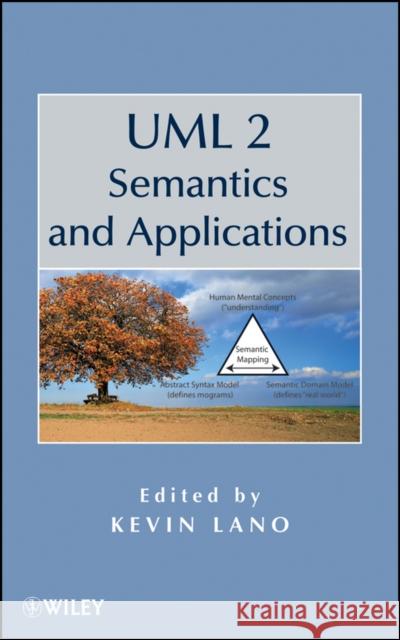UML Semantics » książka



(netto: 593,90 VAT: 5%)
Najniższa cena z 30 dni: 619,75
ok. 30 dni roboczych
Dostawa w 2026 r.
Darmowa dostawa!
With an up-to-date view of the results of UML semantics and the practical applications of semantics development, this book presents the only coherent and integrated account of the leading UML 2 semantics work and its applications.
CONTRIBUTORS.
PREFACE.
1 INTRODUCTION TOTHE UNIFIED MODELING LANGUAGE (Kevin Lano).
1.1 Introduction.
1.2 Class Diagrams.
1.3 Object Diagrams.
1.4 Use Cases.
1.5 State Machines.
1.6 Object Constraint Language.
1.7 Interaction Diagrams.
1.8 Activity Diagrams.
1.9 Deployment Diagrams.
1.10 Relationships Between UML Models.
1.11 Summary.
2 THE ROLE OF SEMANTICS (Kevin Lano).
2.1 Introduction.
2.2 Different Semantic Approaches.
2.3 Applications of Semantics.
2.4 UML Semantics.
2.5 Applications of Semantics to UML.
2.6 Application of Semantics to the Use of UML.
2.7 Summary.
3 CONSIDERATIONS AND RATIONALE FOR A UML SYSTEM MODEL (Manfred Broy, María Victoria Cengarle, Hans Grönniger, and Bernhard Rumpe).
3.1 Introduction.
3.2 General Approach to Semantics.
3.3 Structuring the Semantics of UML.
3.4 The Math Behind the System Model.
3.5 What Is the System Model?
3.6 Usage Scenarios.
3.7 Concluding Remarks.
4 DEFINITION OF THE SYSTEM MODEL (Manfred Broy, María Victoria Cengarle, Hans Grönniger, and Bernhard Rumpe).
4.1 Introduction.
4.2 Notational Conventions.
4.3 Static Part of the System Model.
4.4 Control Part of the System Model.
4.5 Messages and Events in the System Model.
4.6 Object State.
4.7 Event–Based Object Behavior.
4.8 Timed Object Behavior.
4.9 The System Model Definition.
Appendix A.1 State Transition Systems.
Appendix A.2 Timed State Transition Systems.
5 FORMAL DESCRIPTIVE SEMANTICS OF UML AND ITS APPLICATIONS (Hong Zhu, Lijun Shan, Ian Bayley, and Richard Amphlett).
5.1 Introduction.
5.2 Definition of Descriptive Semantics in FOPL.
5.3 The LAMBDES Tool.
5.4 Applications Using Model and Metamodel Analysis.
5.5 Conclusions.
6 AXIOMATIC SEMANTICS OF UML CLASS DIAGRAMS (Kevin Lano).
6.1 Introduction.
6.2 Real–Time Action Logic.
6.3 Semantics of Class Diagrams.
6.4 Application of the Semantics.
6.5 Related Work.
6.6 Conclusions.
7 OBJECT CONSTRAINT LANGUAGE: METAMODELING SEMANTICS (Anneke Kleppe).
7.1 Introduction.
7.2 Metamodeling Semantics.
7.3 OCL Semantics: Types and Values.
7.4 OCL Semantics: Expressions and Evaluations.
7.5 Summary and Conclusions.
8 AXIOMATIC SEMANTICS OF STATE MACHINES (Kevin Lano and David Clark).
8.1 Introduction.
8.2 State Machine Semantics.
8.3 Extended State Machines.
8.4 Semantics for Extended State Machines.
8.5 Solutions for Semantic Problems.
8.6 Structured Behavior State Machines.
8.7 Related Work.
8.8 Summary.
9 INTERACTIONS (María Victoria Cengarle, Alexander Knapp, and Heribert Mühlberger).
9.1 Introduction.
9.2 Trace–Based Semantics.
9.3 Alternative Semantics.
9.4 Implementation and Refinement.
9.5 Verification and Validation.
10 CO–ALGEBRAIC SEMANTIC FRAMEWORK FOR REASONING ABOUT INTERACTION DESIGNS (Sun Meng and Luís S. Barbosa).
10.1 Introduction.
10.2 Why Co–algebras?
10.3 A Semantics for UML Sequence Diagrams.
10.4 New Sequence Diagrams from Old.
10.5 Coercions and Designs.
10.6 A Calculus for Interactions.
10.7 Concluding Remarks.
11 SEMANTICS OF ACTIVITY DIAGRAMS (Kevin Lano).
11.1 Introduction.
11.2 Semantics of Structured Activities.
11.3 Semantics of Intermediate Activities.
11.4 Data Flow Semantics.
11.5 Semantic Analysis.
11.6 Related Work.
11.7 Summary.
12 VERIFICATION OF UML MODELS (Kevin Lano).
12.1 Introduction.
12.2 Class Diagrams.
12.3 State Machine Diagrams.
12.4 Sequence Diagrams.
12.5 Summary.
13 DESIGN VERIFICATION WITH STATE INVARIANTS (Emil Sekerinski).
13.1 Introduction.
13.2 Preliminaries.
13.3 Statechart Structure.
13.4 Configurations and Operations.
13.5 State Invariant Verification.
13.6 Accumulated Invariants.
13.7 Verification Condition Generation.
13.8 Priority Among Transitions.
13.9 Conclusions.
14 MODELTRANSFORMATION SPECIFICATION AND VERIFICATION (Kevin Lano).
14.1 Introduction.
14.2 Categories of Model Transformation.
14.3 Specification of Model Transformations.
14.4 Refinement Transformations.
14.5 Quality Improvement Transformations.
14.6 Design Patterns.
14.7 Enhancement Transformations.
14.8 Implementation of Model Transformations.
14.9 Summary.
INDEX.
Kevin Lano is an Associate Professor in the Computer Science Department at King′s College in London. He currently works on UML–RSDS: Reactive Systems Design Support where he runs the development of a method and toolset for system development using UML and MDA. Professor Lano is also an editor of the journal Software and Systems Modeling.
A coherent and integrated account of the leading UML 2 semantics work and the practical applications of UML semantics development
With contributions from leading experts in the field, the book begins with an introduction to UML and goes on to offer in–depth and up–to–date coverage of:
-
The role of semantics
-
Considerations and rationale for a UML system model
-
Definition of the UML system model
-
UML descriptive semantics
-
Axiomatic semantics of UML class diagrams
-
The object constraint language
-
Axiomatic semantics of state machines
-
A coalgebraic semantic framework for reasoning about interaction designs
-
Semantics of activity diagrams
-
Verification of UML models
-
State invariants
-
Model transformation specification and verification
Additionally, readers are provided with expert guidance on how to resolve semantic problems and a section on applications of UML semantics with model analysis. UML 2 Semantics and Applications is an ideal resource for researchers and tool–builders working in UML, among others. It is also an excellent textbook for postgraduate teaching and research.
1997-2025 DolnySlask.com Agencja Internetowa
KrainaKsiazek.PL - Księgarnia Internetowa









